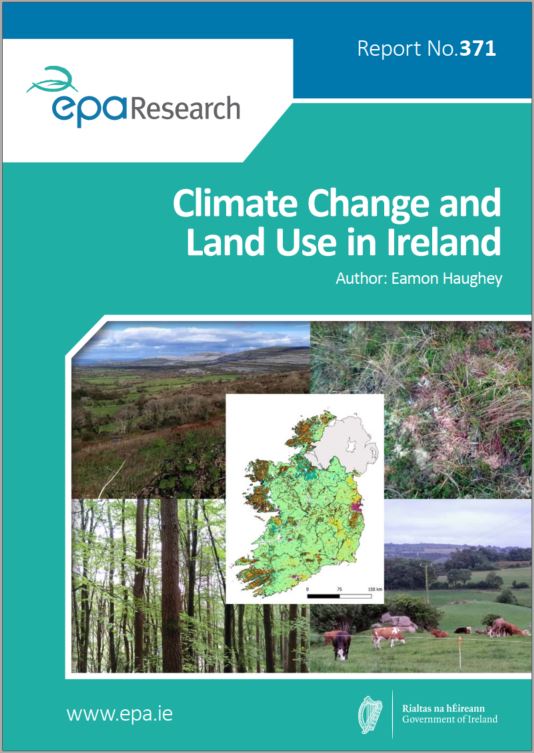Research 371: Climate Change and Land Use in Ireland
Author: Eamon Haughey
Summary: Land supports a range of ecosystem services including biodiversity and economic outputs in the agriculture and forestry sectors. This report identified pressures in the land system by analysing land use and outputs and greenhouse gas emissions associated with the land system. It identifies knowledge gaps in relation to national land use mapping, which currently limit the potential for regional analyses of land–climate interactions.

Project Highlights
Watch the project highlights video
Identifying Pressures
Land supports a broad range of ecosystem services, including biodiversity and carbon storage, as well as economic outputs in the agriculture and forestry sectors. This project identified pressures in the land system in Ireland by analysing land use and outputs as well as greenhouse gas emissions associated with the land system. Ireland faces a specific set of challenges in terms of greenhouse gas emissions related to the land system. The dominance of grasslands and ruminant livestock-based agriculture means that a relatively large proportion of Ireland’s total greenhouse gas emissions are attributable to the agriculture sector. Furthermore, relatively low forest cover, declining rates of afforestation and a large area of degraded peatlands means that the land use, land use change and forestry sector in Ireland is also a significant net source of greenhouse gas emissions.
Informing Policy
The high-level overview of Ireland’s land use system and its outputs carried out for this report considered key messages from the Intergovernmental Panel on Climate Change Special Report on Climate Change and Land in a national context and found that agriculture and the land use change and forestry sectors clearly present major challenges to the achievement of Ireland’s climate mitigation goals. The IPCC report describes 40 integrated response options to adapt to climate change and mitigate its effects. An analysis of the extent to which these integrated response options are applicable to Ireland found that 12 of the 40 were highly applicable. The analysis also identified areas where there are significant knowledge gaps and where further research is needed to enable increased uptake of response options. The analysis of response options, although at a high level, can be used to inform policy in Ireland with the aim of improving the impact of climate mitigation and adaption actions and identifying potential synergies.
Developing Solutions
A range of highly applicable options are available to simultaneously address climate change mitigation and adaptation in the land system in Ireland. Of note is that several of the options applicable to the agriculture sector are aimed at increasing productivity, but, if not carefully implemented, these could in fact increase overall greenhouse gas emissions as a result of rebound effects. Other options, such as agroforestry and agricultural diversification, face major barriers to uptake and this report recommends research that should be carried out to better inform policymakers. However, in many cases it is difficult to estimate the potential impact of response options because local data and analysis are limited. The report also identifies knowledge gaps in relation to national land use mapping, which currently limit the potential for regional analyses of land–climate interactions. Nevertheless, this report provides the basis for prioritising future research at the land–climate interface. Such work can also contribute to international efforts to develop scalable land-based solutions to climate change.
https://www.epa.ie/media/epa-2020/research/epa-funded-research/Twitter_371.jpg